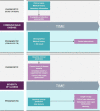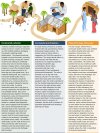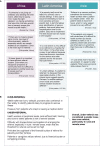Anticipating the future: prognostic tools as a complementary strategy to improve care for patients with febrile illnesses in resource-limited settings
- PMID: 34330761
- PMCID: PMC8327814
- DOI: 10.1136/bmjgh-2021-006057
Anticipating the future: prognostic tools as a complementary strategy to improve care for patients with febrile illnesses in resource-limited settings
Abstract
In low-income and middle-income countries, most patients with febrile illnesses present to peripheral levels of the health system where diagnostic capacity is very limited. In these contexts, accurate risk stratification can be particularly impactful, helping to guide allocation of scarce resources to ensure timely and tailored care. However, reporting of prognostic research is often imprecise and few prognostic tests or algorithms are translated into clinical practice.Here, we review the often-conflated concepts of prognosis and diagnosis, with a focus on patients with febrile illnesses. Drawing on a recent global stakeholder consultation, we apply these concepts to propose three use-cases for prognostic tools in the management of febrile illnesses in resource-limited settings: (1) guiding referrals from the community to higher-level care; (2) informing resource allocation for patients admitted to hospital and (3) identifying patients who may benefit from closer follow-up post-hospital discharge. We explore the practical implications for new technologies and reflect on the challenges and knowledge gaps that must be addressed before this approach could be incorporated into routine care settings.Our intention is that these use-cases, alongside other recent initiatives, will help to promote a harmonised yet contextualised approach for prognostic research in febrile illness. We argue that this is especially important given the heterogeneous settings in which care is often provided for patients with febrile illnesses living in low-income and middle-income countries.
Keywords: diagnostics and tools; diseases; disorders; health systems; infections; injuries.
© Author(s) (or their employer(s)) 2021. Re-use permitted under CC BY. Published by BMJ.
Conflict of interest statement
Competing interests: None declared.
Figures



References
-
- World Health Organization . Informal consultation on fever management in peripheral health care settings: a global review of evidence and practice. Geneva, 2013.
Publication types
MeSH terms
Grants and funding
LinkOut - more resources
Full Text Sources
